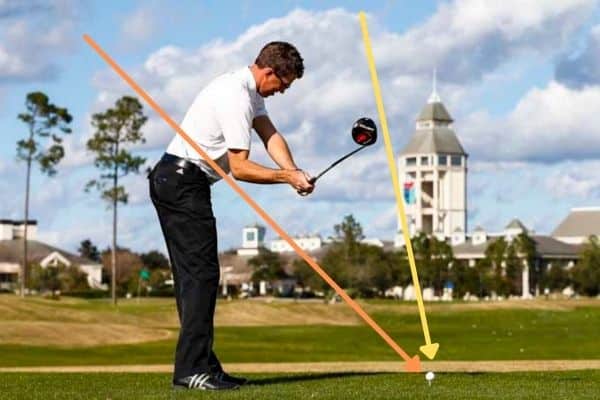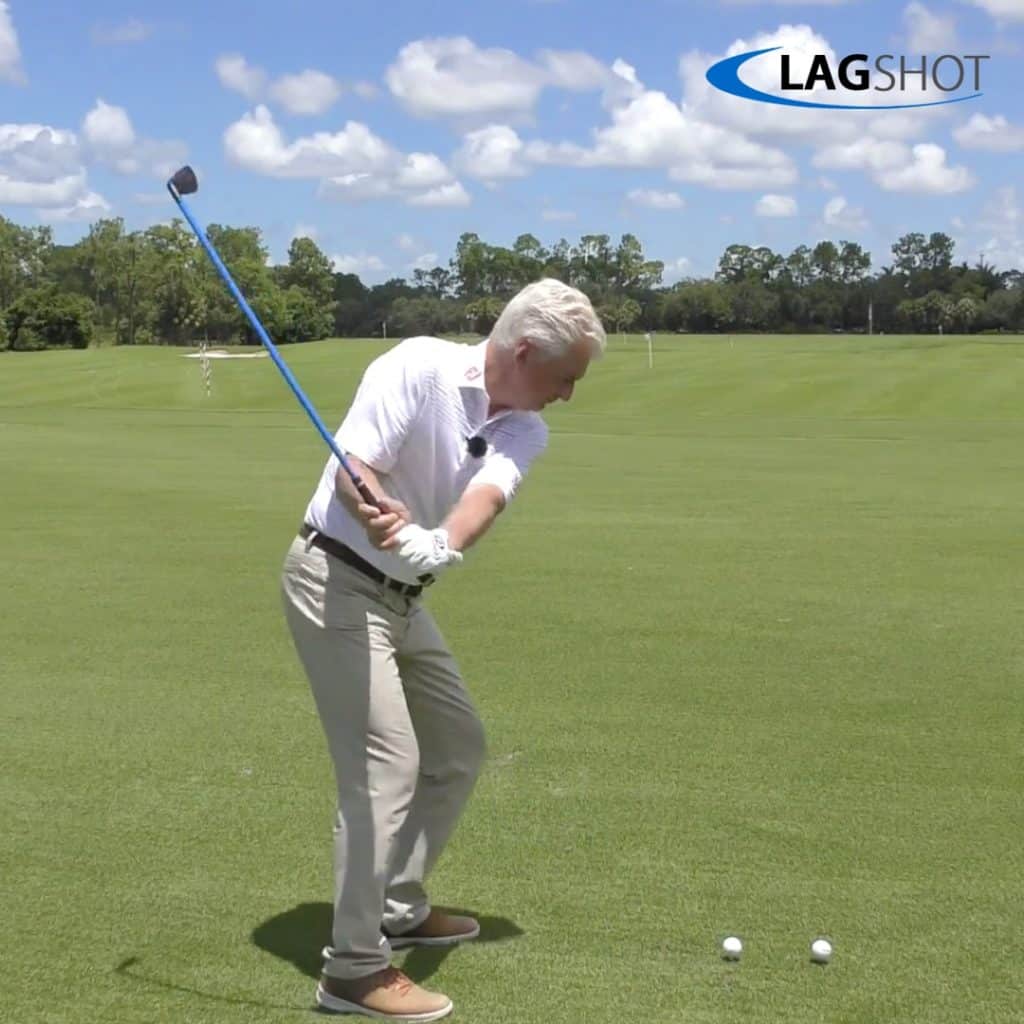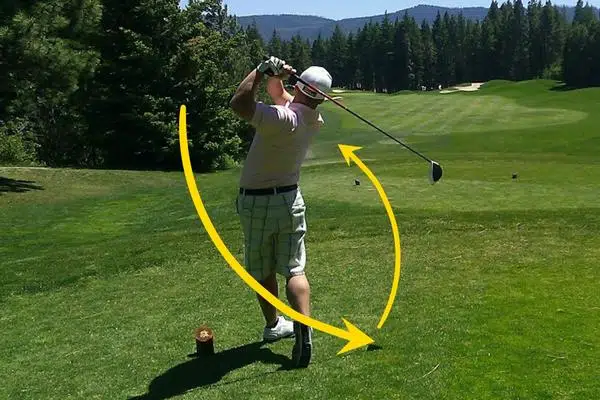A poor club path can be an absolute killer in golf and if you swing it on a bad line it can feel like your ball flight always lacks that power and trajectory you envy when watching the pros play.
One of the most dreaded threats to a golf swing is an out-to-in path, otherwise known as ‘coming over the top’ or ‘from the outside’, which can cause weak, high slices.
We’ve all heard other players, commentators on TV or golf instructors say that to fix an over-the-top swing you need to develop an in-to-out club path – a moved commonly referred to as ‘swinging from the inside’ – in order to straighten your flight, become more consistent and gain extra distance.
So, how do you do it?
To swing from the inside in golf, you must turn your hips and shoulders deep into your right side to reroute your club onto a more inside path. It’s also important to shallow the golf club at the top of the swing, allowing it to drop a little at the completion of the backswing to bring it onto a more inside path.
Golfers who swing with their arms, without much rotation, are more likely to come over the top, throwing the clubhead out at the ball.
Essentially, rotation throughout the swing and shallowing at the top of the backswing are the real keys to swinging from the inside and both are easily transformed through regular practice.
If you have poor flexibility restricting your hip turn, then it may pay to do a little bit of stretching or use something like a foam roller prior to each round to help loosen the body up and allow the proper rotation.
Personally, I have had a stiff back for years and find a heat pack does wonders for relaxing the muscles prior to playing.
Keep reading to learn more about how you can swing from the inside in golf and add extra distance and better accuracy to your game.
Table of contents
Should a golf swing be inside-out or outside-in?
Your golf swing should be more in-to-out in terms of swing path, but you can still make an out-to-in path work for you. Swinging more from the inside can help hit the ball higher, and draw it, by generating extra speed. While it isn’t essential to have an in-to-out swing path, it should be something all golfers aim for, given the benefits it can provide.
The biggest reason why anyone should try and swing with more of an in-to-out path is as a remedy to slicing the ball, as a shot shape that bends off to the right is usually a result of an out-to-in path, otherwise known as coming ‘over the top’.
An over the top swing – which will lead to an out-to-in path – is going to cause slicing, weak shots that never quite feel as if they find the centre of the club or ‘pop’ off the clubface.
I struggled with this issue for a long time and despite being young, fairly powerful and having a good amount of swing speed, I often hit the ball low and could only get my driver out there about 230 yards.
Through working on coming more from the inside, I added more height and another 30 yards in distance to my game almost overnight once I rerouted my swing path.
A great little video and drill from James Robinson Golf (below) outlines the how and why behind an inside-out club path.
An in-to-out swing path is going to promote increased backspin with your irons and more height; two factors that are really going to help you hit more greens and stop the ball dead, rather than it run through the putting surface.
It can be a little tricky to comprehend as often a slice is associated with a higher ball flight, but keeping a good level of dynamic loft, while maintaining a downward strike, will be far easier to perform with an in-to-out swing.
This will lead to powerful strikes that will carry a good distance, but do so with a high flight, meaning that they will travel the desired journey but stop quicker when they reach their destination.
Why can’t I swing inside-out in golf?
If you can’t swing inside-out, it is likely due to an over-the-top path caused by a lack of rotation, poor takeaway or a failure to shallow the golf club. If you sway, rather than rotate, your club will come down from the top at a steep angle, causing low dynamic loft. Performing a takeaway that is in line with your target, rather than outside your target line, will help you find an inside swing path.
One of the biggest brick walls people hit with their golf swing is being overly stiff and sore, hindering their ability to rotate.
The only way they can swing back and through is with swaying, dipping or a making steep swing; all of which will never lead to optimum golf shots.
Foam rolling before a round can really help loosen up the hips and help you rotate, rather than dip or slide.
If you are generally limber and rotate quite well, it’s possible you bring the club up to parallel too far away from your body in the takeaway.
Using an alignment stick pointing towards your target when practicing will help you have a visual aid to align the shaft, making sure that the club is working a little more towards the inside in the early stages of the swing.
Finally, a shallowing of the club at the start of the downswing is crucial to make a powerful strike with an appropriate level of dynamic loft.
If you struggle with low or weak shots, you probably steepen the club when transitioning into the downswing by throwing the hands and wrists away from your body, rather than dropping the club deeper into your swing, helping it to come in on a shallower trajectory.
We have written a comprehensive article about shallowing the golf club, which explains that allowing the clubhead to drop down towards the ground behind you, prior to moving into the downswing, will help you find a more inside path.
There are several training aids that will give you great feedback at contact so you know for sure whether your club did in fact come from an inside line.
Everything from the pricey but sensational FlightScope Mevo to a cheap divot board will give you great real-time feedback on your swing path.
What causes an outside-to-inside golf swing?
An out-to-in swing, usually associated with an over-the-top club path, is caused by excessive use of the upper body in the golf swing. At the top of the swing, rather than allowing gravity to drop the club ‘into the slot’, golfers who swing out-to-in will throw the golf club away from their body, steepening the angle of the shaft and causing a glancing strike of the ball.
But, what exactly leads somebody to do this?
One of the biggest culprits is probably a fear of rotation, thinking that turning deep into the backswing and allowing the club to shallow will cause violent hooks.
Now this can be the case, but the cause of the hooks is unlikely to be rotation of the body and more so a poor grip or overly deep takeaway.
It’s important to consider the fact that while the body rotates, the club moves up as well as around, and getting this in sync is vital to overcome the fear that a deep turn will equal a big hook.
Set up is important to consider too, as lining up open to target will promote a swing where the club comes down on an out-to-in path.
Having feet, hips and shoulders aligned to target may help you find a more inside path relatively quickly.
Grip can also be a leading cause of an out-to-in swing, particularly if you play with quite an open clubface.

If you have a weak grip and tend to lose balls with a slice, an out-to-in path caused by coming over-the-top will help to square this off.
Unfortunately, despite the clubface being square, the attack angle is often steep and shots will be low, lacking power and penetration.
I definitely think purchasing a golf grip trainer like this one from SKLZ is a worthwhile expense, leaving nothing to chance and literally forcing your hands into the right position when practicing (remember, though, you can’t legally use this tool on course during competition).
Do any golf pros swing out-to-in?
Australian golfer Craig Parry had great success with an out-to-in swing, and some current PGA Tour players like Abraham Ancer utilise a similar over-the-top motion. However, none of these movements are excessive. While these guys are talented enough to perform at the highest level with this swing path, amateur golfers usually lack the skill to strike the ball efficiently with an out-to-in motion.
One of the biggest questions you need to ask yourself in golf is ‘what do you actually want to get out of the game?
If consistent golf with reasonable scores – perhaps in the mid 80s – makes you happy, then if you can achieve this with an out-to-in swing path, there’s probably no reason to change.
However, if you have dreams of going low, shooting even par and possibly progressing towards scratch golf, then rerouting your swing to come more from the inside may be necessary to get the power, accuracy and distance required to hit more bombs and get into wedge range for more approaches.
Top drills to get you swinging on an in to out path.
Collect the Ball Drill
One of the reasons people come over-the-top in the golf swing and struggle to strike the ball with an in-to-out path is a takeaway that travels too far away from the body.
Rather than dragging the club back to a point where it lines up with the target when parallel to the ground, many people take the club away well in front of their body, causing the club shaft to point way to the left of their target.
This is why it’s always useful to practice with an alignment stick so you have awareness of your target line.
A simple drill to start working the club away more towards the inside involves placing a second ball about a foot behind the ball you are hitting, with the aim being to collect and brush the second ball backwards when taking the club away.
This will promote a club path more from the inside, helping you to strike the ball on an in-to-out trajectory through contact.
Lag Shot Drill
One of our favourite training aids is the Lag Shot, which is a practice golf club with a super bendy shaft that promotes a good tempo and a lagging swing that comes from the inside.
The bendy shaft makes it very difficult to ‘cast’ the club away from the body in an over-the-top fashion, causing you to pause at the top, allow the club to lag a little, then come down strong from the inside.
Whether you truly understand the factors at play here doesn’t really matter, which is ultimately why it’s such a great tool to use when working on your swing.
Practice with the Lag Shot on the range and you’ll find in time that it trains you to come from the inside when returning to your normal shafted clubs.

Pause drill
It can be really challenging to change a bad habit when swinging at full pace, as muscle memory takes over and everything just happens so quickly that you revert to old ways.
This is why the pause drill can be so helpful, using a slow, methodical approach to rerouting your path to gradually develop a new habit.
Perform some small swings where you only bring the club to halfway before pausing.
After the pause, feel as if your club drops a little in behind you, then make an accentuated swing well out to the right of your target.
Gradually increase the pace and fullness of your swing, working on that little movement at the top where the club drops into the slot, allowing you to swing more to the right of target.
With a slightly closed clubface, this should create a powerful draw.
Final message
An over the top move that creates an out-to-in swing path is such a common flaw in golfers and unfortunately can have a real negative impact on power and ball flight.
By working on your rotation and a few of the drills suggested, there’s no reason why you cant reroute your swing, no matter how deeply embedded in muscle memory, to come more from the inside and find that high, powerful draw.


